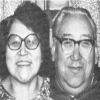 ,
, 
This is the continuation of an interview with Faye Nusunginya (Kimmialuk) on March 12, 1982 by Bill Schneider and Wendy Arundale at her home in Barrow, Alaska (now known as Utqiaġvik) for the Chipp-Ikpikpuk and Meade Rivers Oral History Project. Faye's daughter and son-in-law, Mary (Amayun) and Charlie Edwardsen, Sr. (Aaluk) participated in the interview as Iñupiaq language translators and also added their own comments. In this second part of a two part interview, Faye talks about the sites of Ugaari and Suqłiat, how they got their names, how they've been used, and how they've changed through time, especially regarding erosion. (IHLC Tape #00055)
Faye Nusunginya spoke in Iñupiaq during the interview. The transcript contains the spoken Iñupiaq written out and its corresponding English translation, both provided by Kathy Itta (now Ahgeak).
Digital Asset Information
Project: Chipp-Ikpikpuk and Meade Rivers Oral History Project
Date of Interview: Mar 12, 1982
Narrator(s): Faye Nusunginya
Interviewer(s): Bill Schneider, Wendy Arundale
Transcriber: Katherine Itta Ahgeak
After clicking play, click on a section to navigate the audio or video clip.
Sections
Ugaari and how it got its name.
Suqłaich and a school that had recently started there.
Click play, then use Sections or Transcript to navigate the interview.
After clicking play, click a section of the transcript to navigate the audio or video clip.
Transcript
Bill: What do you call this place? Where Amaguaq had a cabin. Charlie: This is -- That's -- They call it Yugaari. Bill: What does that mean? Charlie: I don't know. Faye: Iñuum atqanik atiliġuugaitkii iñuum sugiviraanik. Taamnauvva Ugaari iḷuviqaqsimaruaq tatqamma Yugaarimigguuq. (Well, they used to name them with people's names, where a person did something. Ugaari had a grave there, Ugaari himself.) Charlie: She said there's a grave there that's named Ugaari. Bill: A person? Charlie: Yes. Faye: That's what they said. I see the box of him but I didn't go to it. How it is. Maybe 1922 or '23. Bill: Were there lots of people there? Charlie: There were some people there during my time, like the Leavitt's. Jonah Leavitt had a cabin here. That's what they call Imaġruaq. This end where the mark is. And that's that lake that's named that too. Faye: Immaqanuq imaiġñivḷugu tusaaŋammiruaŋaasii. (I have heard that there is no more water in that lake.) Qalliŋagaa ami. (It has come close to it anyway.) Charlie: Imaiŋamaruaq. Aqayaaġruġuqsiññaŋamaraa nalautchaaġaapku qaŋaimña. (There was no more water in it. All there was leŋt was mud when I passed by it.) Faye: Iqalugiksumiḷu. (And it had real good fish too.) Charlie: That place used to have some real good fish. Faye: Real fat fish in that lake. Charlie: But it's drained out. You can see the cat train trail, they come right through there and follow it up to Tasiqpak Lake, and they notched that and that's what happened. They notched the ground. Disturb it. Right through there, and that's dry now. Bill: Do you remember people camped there when you were a little girl? Faye: Yes. Long time. Had lots of iglu (houses) but that wash it out, part of it, yeah. But some of them maybe right down there. First houses they wash it away. I don't know how many. Wendy: So you saw Yugaari's grave in about 1922 or '23 you think... Faye: Early twenties. Mary: I was born in 1924. Faye: Maybe '22 or '23, something like that. Wendy: That's good. Bill: So people were camped there. That's an important spot. Charlie: Yes, they were camped in there. Faye: Qiruktaġaptakii tautuguugikput. Tatkivaŋŋa imaġruamiñ. (We used to see it whenever we went to get wood from Imaġruaq over there.) Charlie: I can't see why they didn't put them dots on like this right here where there used to be lots of cabins right there. Mary: Maybe they're washed out too. Charlie: Can't be. It's on land. Piñauvva pigiga una Suqłaich. Igluugaluaqsimaruq tamarra uniaġaquŋa tavruŋaġama. (I am referring to Suqłaich. There were lots of houses when I passed through there by dogteam.)
Bill: Maybe Charlie show us one more time where Suqłaich is. Charlie: Yeah, Suqłaich. Faye: Iglukkaluatkii nuŋutchuugait... (The houses do erode away...) Mary: Uvvalu nuna maġġaq sausuuruq. (And the land...the sand covers too.) Charlie: Right around that area where the creek comes out. Right around here. There were several iglus there. I've been in one home. Bill: Call it. CE-1. Charlie: They call it Suqłaich. There's a lot of ice cellars there. I was going to show you, that bluff there where they got cabin too. Wendy: That's where the school has that... Charlie: Yes. That school...before that there used to be Sakeagak's cabin in there before the school. Mary: School just started about two years ago, to go there. Survival school. Charlie: That guy that used to stay there, he's the one that's teaching them. And they build a house for him too at Tasiqpak.

